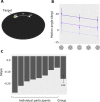Touch as an auxiliary proprioceptive cue for movement control
- PMID: 31183406
- PMCID: PMC6551167
- DOI: 10.1126/sciadv.aaw3121
Touch as an auxiliary proprioceptive cue for movement control
Abstract
Recent studies extended the classical view that touch is mainly devoted to the perception of the external world. Perceptual tasks where the hand was stationary demonstrated that cutaneous stimuli from contact with objects provide the illusion of hand displacement. Here, we tested the hypothesis that touch provides auxiliary proprioceptive feedback for guiding actions. We used a well-established perceptual phenomenon to dissociate the estimates of reaching direction from touch and musculoskeletal proprioception. Participants slid their fingertip on a ridged plate to move toward a target without any visual feedback on hand location. Tactile motion estimates were biased by ridge orientation, inducing a systematic deviation in hand trajectories in accordance with our hypothesis. Results are in agreement with an ideal observer model, where motion estimates from different somatosensory cues are optimally integrated for the control of movement. These outcomes shed new light on the interplay between proprioception and touch in active tasks.
Figures





References
-
- E. P. Gardner, K. O. Johnson, in Principles of Neural Science, E. R. Kandel, J. H. Schwartz, T. M. Jessel, S. A. Siegelbaum, A. J. Hudspeth, Eds. (McGraw-Hill, ed. 5, 2013), pp. 451–471.
-
- Pruszynski J. A., Johansson R. S., Flanagan J. R., A rapid tactile-motor reflex automatically guides reaching toward handheld objects. Curr. Biol. 26, 788–792 (2016). - PubMed
-
- Lederman S. J., Klatzky R. L., Extracting object properties through haptic exploration. Acta Psychol. (Amst) 84, 29–40 (1993). - PubMed
-
- Proske U., Gandevia S. C., The proprioceptive senses: Their roles in signaling body shape, body position and movement, and muscle force. Physiol. Rev. 92, 1651–1697 (2012). - PubMed
-
- Edin B. B., Abbs J. H., Finger movement responses of cutaneous mechanoreceptors in the dorsal skin of the human hand. J. Neurophysiol. 65, 657–670 (1991). - PubMed
Publication types
MeSH terms
LinkOut - more resources
Full Text Sources
Medical

